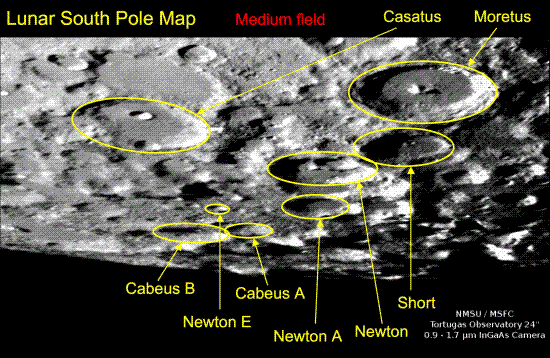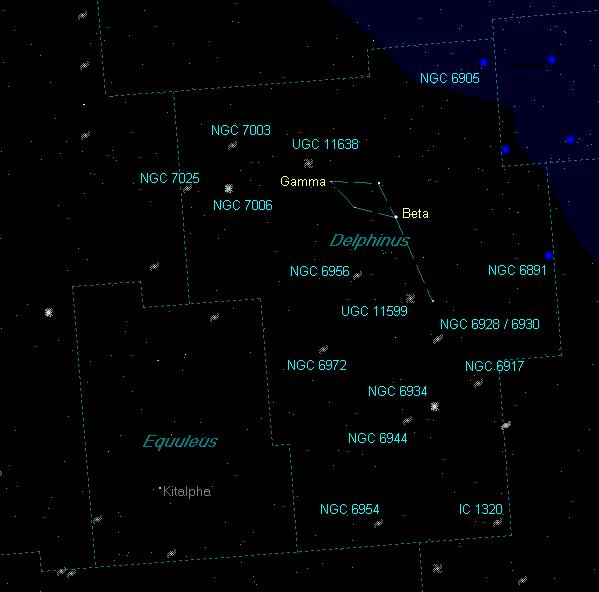A Real Time Lunar Impact
On the morning of October 9th, the Lunar CRater Observation and Sensing Satellite (LCROSS) will crash land into the moon. Is this spacecraft out of control you might ask? On the contrary. This deliberate impact is a planned end to a mission that had a bit of a hiccup last month.
An anomaly was discovered on a communication pass on August 22nd. For some reason, LCROSS was consuming large amounts of fuel when it was out of view. After the mission control team re-booted the Inertial Reference Unit (IRU), everything seems back to normal and the mission is on track.

The main mission of LCROSS is to look at lunar craters that might hold frozen water in the Moon’s Polar Regions. This water would be the remnants of comets that hit the Moon long ago. Comets are known to consist of ice along with other compounds – essentially a dirty snowball. Upon impact, these ices melt but do not survive this state very long. Temperatures on the sunlit side of the Moon reach a blistering 107 degrees Celsius or a little higher than the boiling pint of water. Whereas a logical place to preserve ice would be in the shadows of some deep craters that never receive sunlight. Here temperatures can remain at a constant -153 degrees Celsius. Astronomers estimate that a tonne of lunar soil may contain a litre of water – but frozen of course.
For a few months, the LCROSS team has contemplated a few candidate sites and Cabeus A has been selected as the LCROSS’s final target. On Sept 29th the team changed the target to Cabeus (proper). For now, the impact time is scheduled for 4:30 AM PDT but will be closer refined within hours of impact. Check the LCROSS website for updates. Those armed with webcams and at least a 10-inch telescope should catch the flash.
First, the upper stage of the rocket that launched the spacecraft will hurl itself at 9,000 kilometres per hour into Cabeus at co-ordinates. Four minutes LCROSS itself will end its life in a blaze of glory. On its final seconds before impact, LCROSS will descend into the ejecta made by the rocket. The ejecta is expected to rise about 10 kilometres above the lunar surface and emerge into the sunlight, thus allowing major Earth-based observatories to look for signs of water vapour. It is also an excellent opportunity to catch the event on a web camera hooked up to a moderate-sized telescope. For those living in eastern Canada, the Sun will rise at 7:09 AM and could interfere with seeing and recording is a rare event but if it is clear, try it anyways.
Delphinus the dolphin is one of the smallest constellations in the night sky. With only 189 square degrees of territory, Delphinus is ranked 69th in the area and holds a couple of planetary nebulas as well as a few NGC and UGC objects.
Looking at the diamond shape with a trailing star, we can easily pick out the shape (asterism) of the dolphin. The nose or Gamma Delphi is a lovely double star. Its two components consist of a magnitude 4.3 yellow F7 subgiant star together with a magnitude 5.1 yellowish-green dwarf star. They lie 104 light-years from Earth and takes about 3,200 years to dance around each other. The two suns come as close as 40 astronomical units (distance from Pluto to our Sun) to as far as 600 astronomical units. In a telescope, the two have a 9.6 arc-second separation and currently, the secondary star’s position angle is 268 degrees. Beta Delphi – aka Rotanev is a very close visual binary (in line of sight only) with a half an arc second separation.

The first of two nice planetary nebulas is NGC 6891. A small telescope will show its small disk, but at least an 8-inch instrument is needed to reveal the small magnitude 12.5 central star. To see its bluish halo of star-stuff – larger apertures are a must. Also, look for NGC 6905 towards the North West quadrant of the constellation’s borders. It measures 1.7 arc minutes wide and lists at magnitude 12.5. Also referred to as the Blue Flash, NGC 6905 appearance is stunning. Along with its tinge of colour, the planetary is nestled with many stars close to the Milky Way. Once an OIII filter is used, its uniformed brightness now becomes mottled.
| Object | Type | Magnitude | R.A. | Dec. |
|---|---|---|---|---|
| IC 1320 | Spiral galaxy | 14.0 | 20h 26m | +02° 55' |
| NGC 6891 | Planetary nebula | 12.5 | 20h 15m | +12° 42' |
| NGC 6905 | Planetary nebula | 12.5 | 20h 22m | +20° 07' |
| NGC 6928 | Elongated galaxy | 12.6 | 20h 32m | +09° 56' |
| NGC 6956 | Round galaxy | 14.0 | 20h 44m | +12° 31' |
| NGC 7006 | Globular cluster | 10.6 | 21h 01' | +16° 11' |
| NGC 7025 | Round galaxy | 13.9 | 21h 07m | +16° 19' |
| UGC 11599 | Spiral galaxy | 13.5 | 20h 36m | +11° 29' |
Moving to the eastern side of the Dolphin’s borders is NGC 7006. Here we see a mottled globular cluster measuring only 3 arc minutes wide or a fifth the size of M13. NGC 7006 might be as much as 200,000 light-years from us, thus putting it outside the galaxy and can be said to be one of the farthest globular clusters of the Milky Way.
Of the 43 galaxies that can be found in Delphinus, two have decent structure and can be a bit of a challenge – depending on the size of telescope. First is UGC 11599, located 50 arc minutes to the east of 2-Epsilon Delphini. This magnitude 14.2 face-on galaxy measure only 2.5 arc minutes and sports a brighter arm that does look a little straightened. Our other target is NGC 6956. This barred spiral is a bit brighter and a tad small then the former object and has a distinctive S shape to it and is also facing us. To find NGC 6956, first, locate Zeta Delphini to the right of Beta. Now draw an imaginary line with Theta Delphini and then continue the same line till you see the galaxy.
Variable star estimates is a great way the amateur astronomer and stargazer can help professionals. Having hundreds of observing reports on a single star that might not behave as it should, will alert the pros to research that star further. The American Association of Variable Star Observers (AAVSO) need observations and has great beginner programs. On that note, R Delphini is a Mira type star with a period of 285 days. Within its almost ten-month period, the star varies in brightness from magnitude 7.6 down to 13.8.
Asteroid 3 Juno can be seen with binoculars. It is now in Aquarius and is at magnitude 7.8. By month’s end, it will faint slightly to magnitude 8.2. This is one of the largest asteroid belt members and is slightly reflective. It is composed of nickel-iron, iron, and magnesium silicates. Dimensions are 320×267×200 km. Use the finder chart to follow it and record its position from night tonight.
As you can see from the chart, the planet Uranus is not too far away. Once you hunt it down, it will be an extremely small greenish-blue dot.
Jupiter is still the attention grabber at public star parties and private observing sessions. The first couple of weeks of October will see it slowing its westward track of retrograde. It becomes stationary on the 13th and then slides in an easterly direction.
Be sure to set your clock early on the morning of October 10th when Saturn Venus Mercury forms a nice trio in the pre-dawn sky. A finally the full Harvest Moon will light up the night skies on October 4th.
Till next month, clear skies everyone.
